Isobel Chetwood moved to her dream home on her birthday just over a decade ago. As she wound up a 40-year career in the NHS as a GP practice manager in Stockport, Greater Manchester, she was keen to return to her roots in Cheshire. She settled in a comfortable house in the quiet village of Plumley.
Chetwood, 68, lives alone. When she moved in, she found a gardener (“I don’t do dirt down me fingernails,” she says, laughing). He made her a raised bed for growing strawberries, alongside a fence that divided her garden from her neighbour’s. “It was beautiful out there,” she says.
All was well until – a little over two years ago – alien shoots began rising like spears from the soil around her strawberry plants, having somehow found a way through the heavy railway sleepers and bricks used to build the bed.
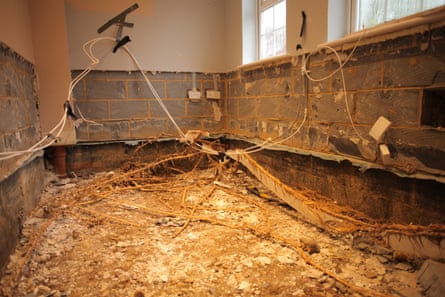

The new plants grew incredibly quickly – and multiplied. Chetwood identified them as bamboo. She suspected they had spread from a plant that the previous tenants in the rented house next door had put in years ago as a living screen.
She alerted the landlord, who assaulted the bamboo with shears and weedkiller. But the attack only hastened the plant’s spread. “The new tenants had two little children and a dog and there were these really sharp spears of bamboo coming up all over their lawn,” Chetwood says. She began to get anxious. “It felt like this was an invasion of my beautiful home.”
Chetwood had become the latest victim of a growing problem that is striking fear into the hearts of homeowners across the country. It is leaving many locked in bitter disputes or facing astonishing bills for work to rip out the plants and rebuild their gardens.
Certain varieties of bamboo that were planted clumsily while the plant was in peak fashion in the 90s and 00s have been silently and invisibly burrowing through garden topsoil. Now, they are rising up, punching through paving stones, asphalt and even the foundations of houses as they dominate any plant life they encounter.
“Bamboo has become the next Japanese knotweed,” says Emily Grant, the director of operations at Environet, a UK specialist in surveying and removing invasive plants. The plants have much in common, having been imported to Britain more than a century ago as exotic ornamental novelties, only to spread underground using creeping stems called rhizomes.
The biggest difference, Grant says, is awareness. Environet recently added questions about bamboo to its annual survey, conducted by YouGov. “In our latest research, 71% of people weren’t aware that bamboo could cause any damage and 84% were not aware that it could prompt legal claims between neighbours or hinder property sales.”

Moreover, because bamboo is often planted intentionally on garden boundaries as a natural fence, the chances of neighbourly disputes are higher than with other plants. And because bamboo can take a decade or more to mature, the problem is often passed on to unwitting owners or tenants before the first shoots start to appear.
There are no restrictions on planting bamboo or any legal requirements to declare its presence when selling a house, as is the case with Japanese knotweed, because it is not legally classified as an invasive species. Yet Grant says a fast-spreading bamboo plant can be just as destructive as Japanese knotweed.
Inquiries about it flood Environet’s Surrey HQ at a rate of 20 a day in the summer, when growth is most rampant. “We started out as 100% focused on Japanese knotweed, but in the three years since we started to offer bamboo removal services, it’s now about 50:50,” Grant says. “And it’s not that we were turning away bamboo work before. We just weren’t seeing the demand.”
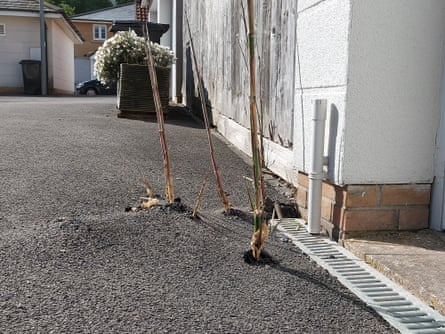
The climate crisis may be a factor. “Warmer summers mean the soils are heating up more than they used to and the plants are able to spread faster,” says Susanne Lucas, an American horticulturist who began specialising in bamboo in the late 80s. She is the CEO of the World Bamboo Organization, which promotes bamboo conservation and the plant’s use in industries such as construction.
Grant blames a careless rush to buy bamboo in the 90s and 00s, driven partly by the aspirational gardening shows that filled the TV schedules. Back then, ignorance dominated the supply chain, particularly when it came to making the vital distinction between bamboo species, of which there are more than 1,000 in the world: is it a “runner” or a “clumper”?
Clumping bamboos tend to grow only upwards and produce new shoots close to the original root ball. For the UK climate, Lucas recommends the fargesia and borinda genera. These varieties now dominate bamboo sales at garden centres, where labelling typically reassures buyers that the plants are clumping and non-invasive.
Running bamboos are the ones to avoid. They have evolved to colonise surrounding ground to create forests, sending out rhizomes that can reach several metres in every direction. Each rhizome produces knuckle-like nodes, from which thick new shoots then reach for the light.
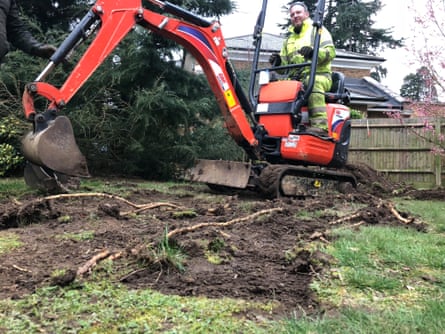
These shoots “come up through the ground at the diameter of the finished bamboo cane”, Grant says. “So they might be 2cm or 3cm across, pushing through the ground at that diameter with a huge amount of force. I get a bit of a shiver down my spine when I see people have planted the more exotic varieties, which can be 10cm across.”
If anything, Chetwood got off lightly. She was terrified about what might be happening in her garden when she began looking up bamboo problems online, where horror stories abound. The worst case Environet has dealt with began in 2019 with a call from a homeowner who spotted a bamboo shoot rising up from behind the skirting boards inside their house in Hampshire. Another shoot had punched through a plaster wall in the sitting room.
Surveyors lifted floorboards to discover that a vast web of rhizomes had been spreading under the house for years, originating from a neighbour’s garden. The only reliable way to remove bamboo is to excavate all the rhizomes. In this case, that meant ripping out all the floorboards and tiles across the ground level, as well as the kitchen and a bathroom, then using a digger and spades to pull out hundreds of metres of runners.

The final bill came to more than £100,000. It was covered by home insurance, but the family had to live in a temporary home for months while builders put their house back together.
In Northamptonshire, a retired homeowner who had planted bamboo more than a decade earlier returned home from a holiday in 2022 to find a shoot growing out of his oven. Work to remove all the rhizomes ended up costing him more than £6,000.
Grant says home insurers typically decide that planting bamboo amounts to negligence – the horticultural equivalent of leaving a tap running and flooding a bathroom. Where damage is caused by a plant on a neighbouring property, that neighbour’s policy may cover the work on the other side of the fence.
“I think it was knocking on the door of about £6,000 on my side and I was worried I was going to have to pay,” says Chetwood, who called in Environet. In the end, she was fortunate to have a sympathetic landlord next door, whose insurer paid for the excavation on Chetwood’s side of the fence (although he had to cough up for the work in his own garden).
Beverley wasn’t so lucky. The retired nurse and her husband moved into a new-build house in Hastings in 2006. A gardener put in two bamboo plants for screening the year after. Almost 15 years later, the plant had spread beneath her and her neighbour’s gardens and shoots were beginning to pop up. “My neighbour was a bit annoyed,” says Beverley, 75. “Then it came so close to the house and I got really scared.”
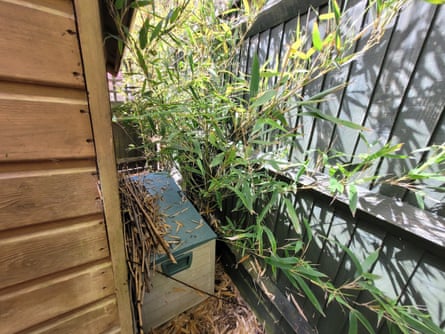
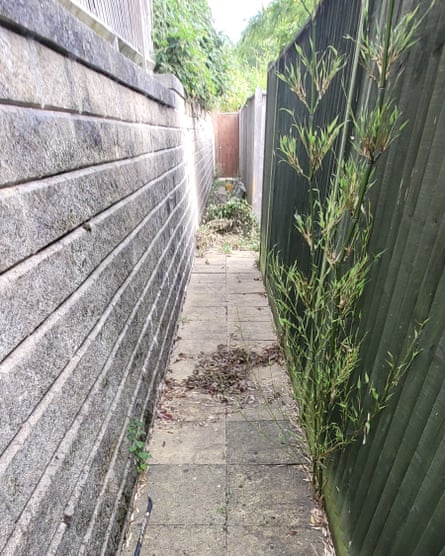

In the past two years, Beverley and her husband have spent almost £10,000 on excavation and the reinstatement of a short public path between the gardens (the bamboo broke the heavy slabs). “It’s a huge expense that we could really have done without, but there’s nothing we can do about it,” she says.
As well as buying clearly marked clumping varieties from reputable suppliers, gardeners should contain bamboo plants, as a precaution, and keep an eye on them. Keeping them in pots, whether buried or on the ground, can help, as can regularly digging a trench around plants to cut off new rhizomes. Vertical root barriers – essentially hard plastic sheeting buried to stop lateral growth – are widely available in gardening shops.
“But containment is only as good as the monitoring of it,” says Grant. “We often see rhizomes jumping over root barriers or breaking through pots.” Left to their own devices, clumping varieties can also cause problems as their root balls expand, especially if planted against fences or walls.
While no law governs the planting or declaration of bamboo (Grant urges buyers to include a check for bamboo in any survey), owners or occupiers may be able to issue proceedings against a neighbour who won’t take responsibility for problem plants under “common law nuisance”. This includes encroachment on a neighbour’s land, damage to a neighbour’s land or interference with a neighbour’s enjoyment of their land.
“We’re seeing a big increase in people bringing claims against uncooperative neighbours,” says Grant, whose colleagues are often called as expert witnesses in such cases. She recommends starting with a chat and then a more formal letter or email if nothing changes. “If an owner has been notified and failed to act, that’s when you can pursue them legally,” she says. “But it can be a lengthy process, and obviously you have to live with your neighbour from then on, so it’s not an ideal course of action.”
Chetwood and Beverley were both lucky: after initial angst, relations with their neighbours were civil. No solicitors were required. Both victims of invasive bamboo are still waiting out the five-year guarantees they paid for on top of the removal work. During this time, their excavation sites are monitored for regrowth, as any piece of rhizome left behind can take root.
“They found some very small shoots the first time and then last February they came for the annual check and there was nothing at all,” Chetwood says. “My garden is all back as it was.” Her strawberry plants didn’t survive, but she is happy with the turf that now borders the fence, which no longer has additional screening. “I certainly wouldn’t get any more bamboo,” she says. “People just stick it in the ground and think it’ll be all right, but it won’t.”
Source: theguardian.com


